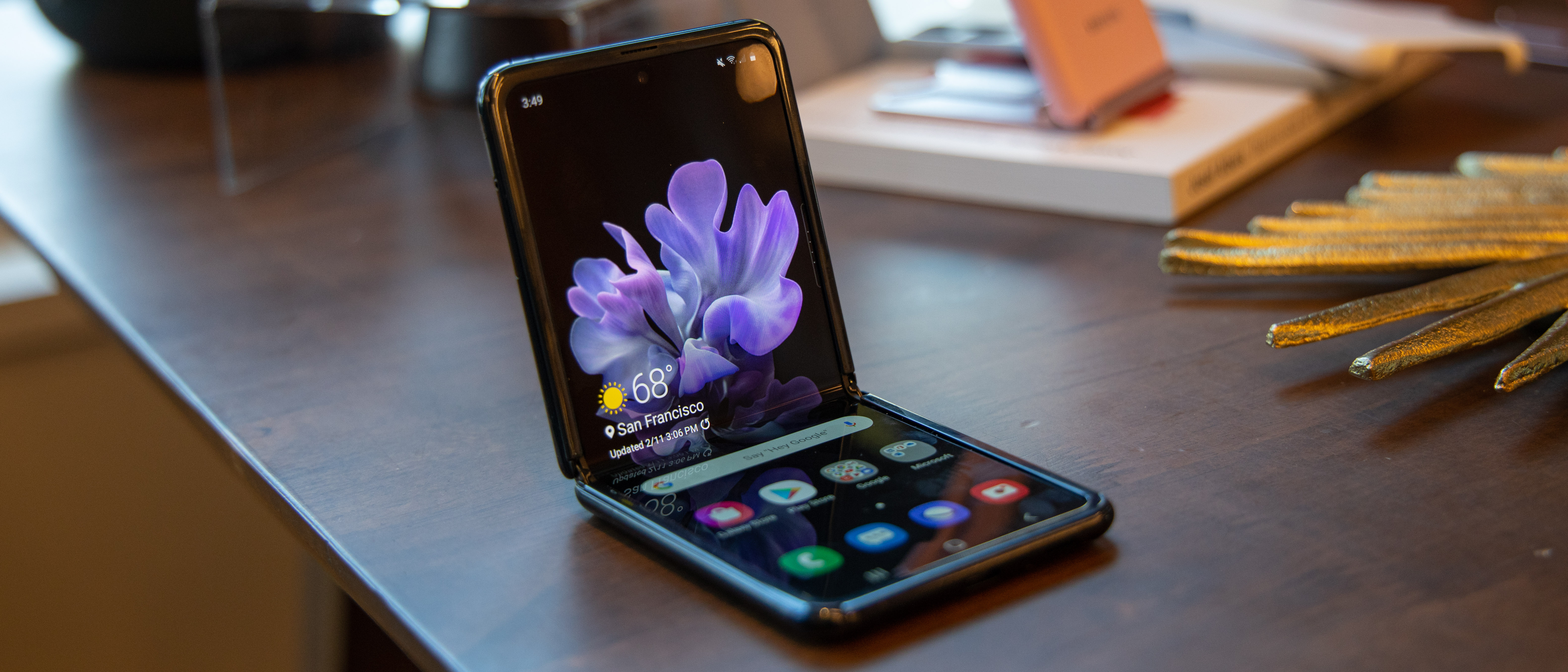TechRadar Verdict
The Samsung Galaxy Z Flip is the flip-phone-style foldable smartphone with a 6.7-inch display that collapses in half. Its novelty will turn heads, but so will its extraordinarily high price. It now comes in 4G LTE or 5G, each with durable thin glass that makes it feel more durable than the Moto Razr foldable.
Pros
- +
Neat folding concept
- +
Cool splitscreen UI
- +
Durable flip design
Cons
- -
Incredibly expensive
- -
Cover Display is tiny
- -
First-gen limitations
Why you can trust TechRadar
Update: our Samsung Galaxy Z Flip review has been updated after more time with the 4G LTE version of this foldable phone. A 5G version has also recently launched.
Two-minute review
The Galaxy Z Flip introduces the flip phone to the smartphone generation thanks to Samsung's bold rethink of how foldable screens work: it collapses in half vertically.
This means the Z Flip (and newer Z Flip 5G) has a big traditional-looking 6.7-inch display that packs up into an incredibly compact clamshell form factor. It instantly has a comforting throwback vibe to it, and yet feels cutting-edge, too.
Its novelty turned heads as we tested this phone in public – the wow factor was off the charts for the Z Flip. People wanted to know how a screen could fold in half, and of course try it themselves. We got the same reaction to the Z Fold and Z Fold 2 that unfolded into tablets, but the Flip was seen as more practical to many people.
As neat as it is, Z Flip is a first-generation device, one that's sure to be refined in an inevitable Galaxy Z Flip 2 in 2021. Our biggest hangup is the 1.1-inch Cover Display on the front; it doesn't offer much info when the phone is closed and sitting on a desk. It has the basics – notifications, the time and battery percentage – but when someone calls and they have a longer name, it has to scroll like a news ticker.
Inside, on the unfolded screen, we dug the Flex UI, which allows for multitasking with two apps and, in some cases, enables the controls of one app to be laid out across the Full HD+ screen. For example, taking a selfie puts the camera preview on the top screen, while all of the controls are on the bottom of the display. And the phone works great half-folded for video calls, acting as an impromptu tripod on a table.
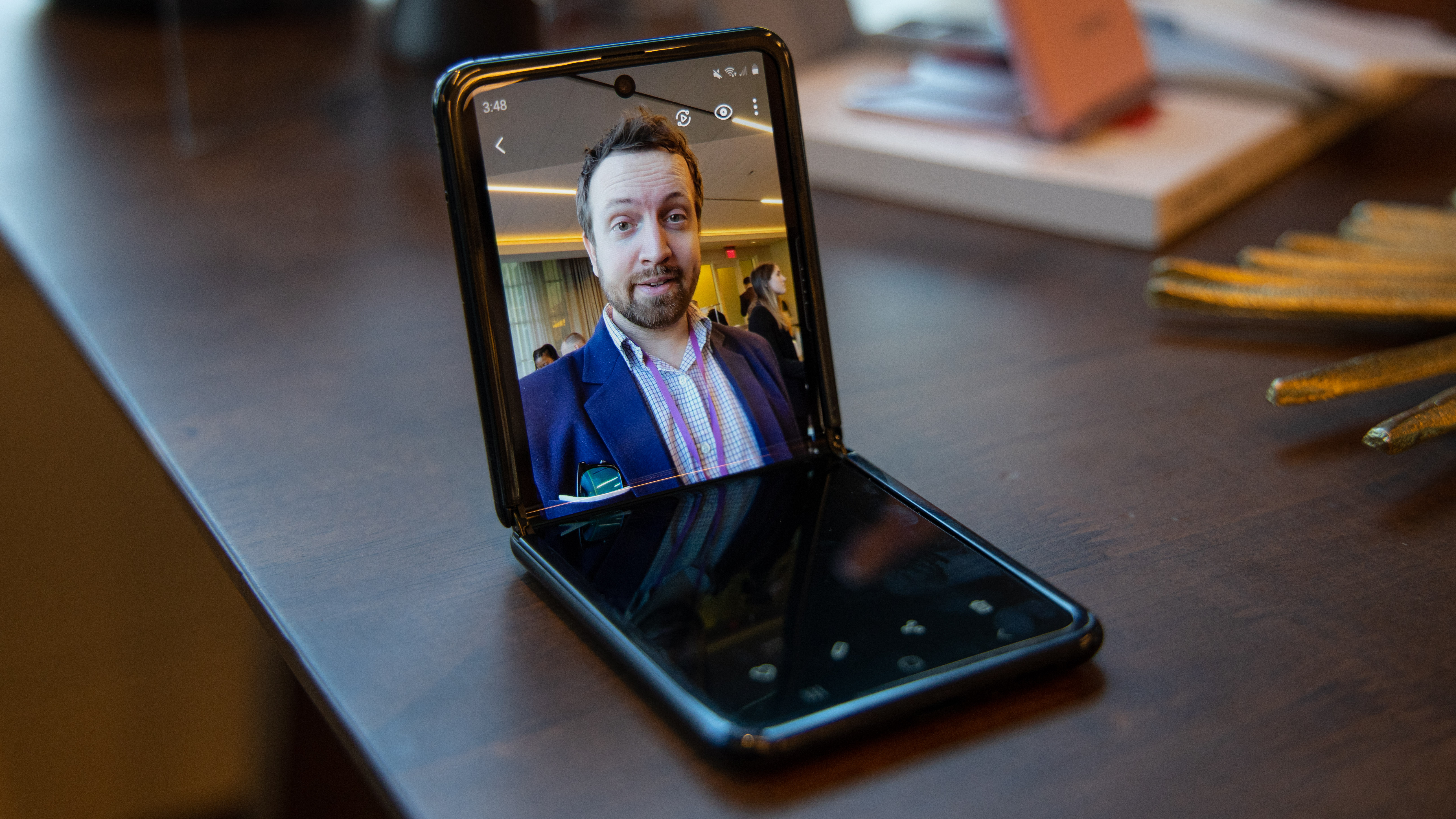
Here's the rub: the Z Flip's half-size portability is a selling point, sure, but the primary reason to buy this phone is make an early adopter super flex. It costs more than the Galaxy S20 and the Note 20 series, yet the camera isn't nearly as good as the Note 20 Ultra. Its specs aren't as good either – 256GB of internal storage and 8GB of RAM.
Expensive and dialed back specs are par for the course for all new, space-deprived foldable phones in 2020. But make no mistake, some are better than others: the Z Flip is the hand-down better foldable vs the equally expensive Moto Razr (and the Moto Razr 2020). We've found Motorola's foldable flip phone disappointing, despite offering tons of nostalgia (many people we showed Samsung's Fold to either called it 'the Razr', or instantly asked about the Razr – please, don't but it for the name).
The Z Flip gets a lot of things right that Motorola got wrong, including stuffing in a bigger battery and thin glass – not plastic – to protect the 6.7-inch inner display. That's still not enough reason for everyone to pay so much money for a phone that's just as pricey as the Note 20 Ultra, which has better cameras and specs. You have to be looking for something new and chic.
The Galaxy Z Flip doesn't necessarily represent a pivot in Samsung's foldable phone strategy – it feels like another an experiment to see which design sticks with consumers. Both the Fold and Flip styles may co-exist. In that regard, it's an experiment with a high asking price, one that's destined to be upgraded in 2021. This will turn heads for the next few months, though the novelty may wear off soon.
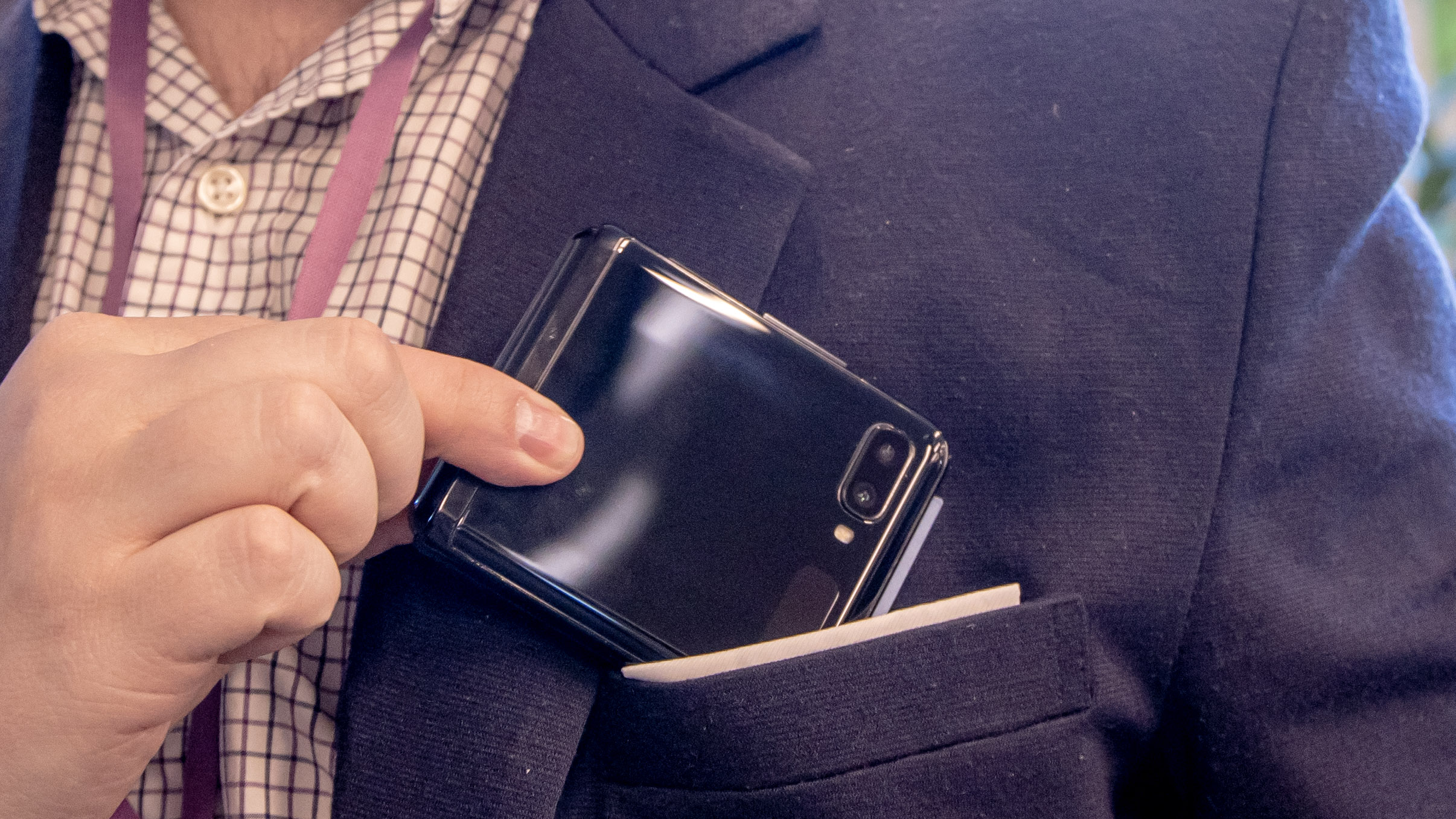
Samsung Galaxy Z Flip release date and price
- Release date (4G LTE): Friday February 14, 2020
- Release date (5G): Friday, July 22, 2020
- High launch price: $1,380 / £1,300 / AU$1,800 (4G LTE)
- Now discounted and easier to find in stock
Like all foldable phones, Samsung's Z Flip launched with an extremely high asking price: $1,380 / £1,300 AU$1,800, and it was impossible to find in stock on its release date: Friday, February 14. Everyone seemed willing to pay for its novelty despite that lofty price. Z Flip colors included Mirror Black, Mirror Purple and Mirror Gold.
The Samsung Galaxy Z Flip 5G carried an even bigger price tag – $1,449 / £1,399 / AU$2,599 when it came out five months later on Friday, July 22, 2020. It not only contained 5G speeds, but upgraded the chipset to the Snapdragon 865 Plus and changed up the color options to Mystic Grey, Mystic Bronze and Mystic White.
There was a $2,480 Z Flip Thom Browne Edition in gray with a red, white and blue strip that was a fashion statement more than anything else. Its limited edition status meant it sold out, but the box came with a leather phone case, the Samsung Galaxy Watch Active 2, and the Galaxy Buds Plus.
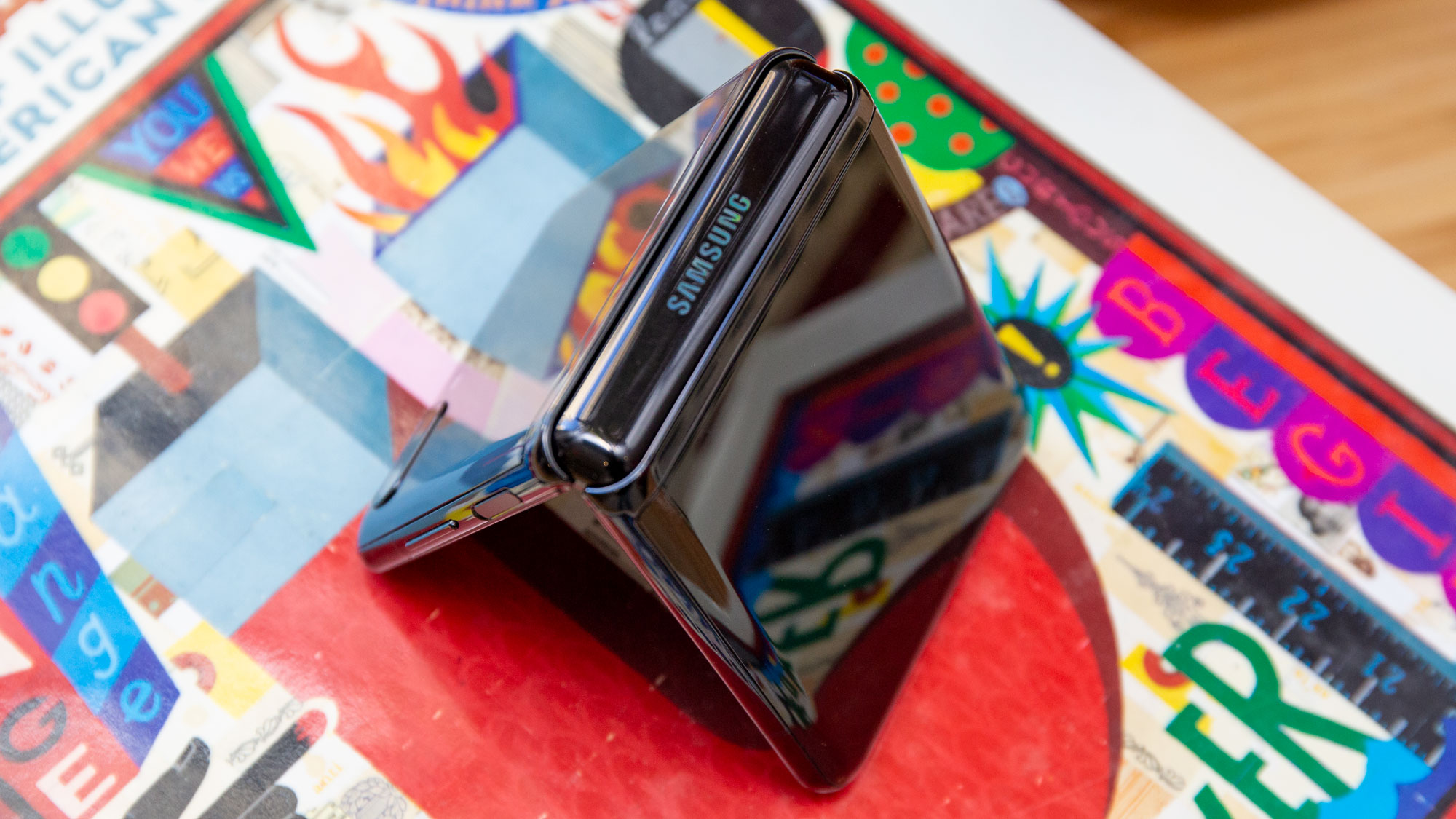
Design
- Candybar-style shape unfolded, clamshell form factor folded
- Hinge feels strong, and the screen crease is faint
- Ideal for those with small hands and tight pockets
The smaller footprint of the Z Flip means it's lighter on specs compared to a flagship phone like the like the Galaxy S20 Ultra, but it's not short on novelty – that it has in spades. Just don't buy it expecting the latest 7nm chipset (in the 4G LTE version), or Samsung's newest cameras or largest battery capacity (in any version).
The Z Flip has a 6.7-inch Full HD+ screen and unique 21.9:9 aspect ratio, so it feels extremely tall in the hand. Its candybar-style shape, when unfolded, makes this take on the idea of a foldable phone distinct compared to the mini-tablet-like Galaxy Fold.
You can see how the phone folds out in the video below:
This is the Samsung Galaxy Z Flip, which is the company's latest foldable phone. It's all yours for just $1,380 or £1,300. The best bit? It's out this Friday in the US and UK #SamsungEvent pic.twitter.com/KsmFqidzYcFebruary 11, 2020
You could easily mistake an opened Z Flip for a typical Android flagship phone if you don't pay attention to the faint crease across the middle of the display; collapse that hinge down, however, and the phone's overall size gets much smaller.
The Galaxy Z Flip design makes it infinitely easier to hold and pocket than a regular smartphone, a win for those of us with smaller hands and tight jacket pockets. Even if it's far chunkier than your average phone when folded in half, overall this is going to be the most compact phone you've owned in over a decade.
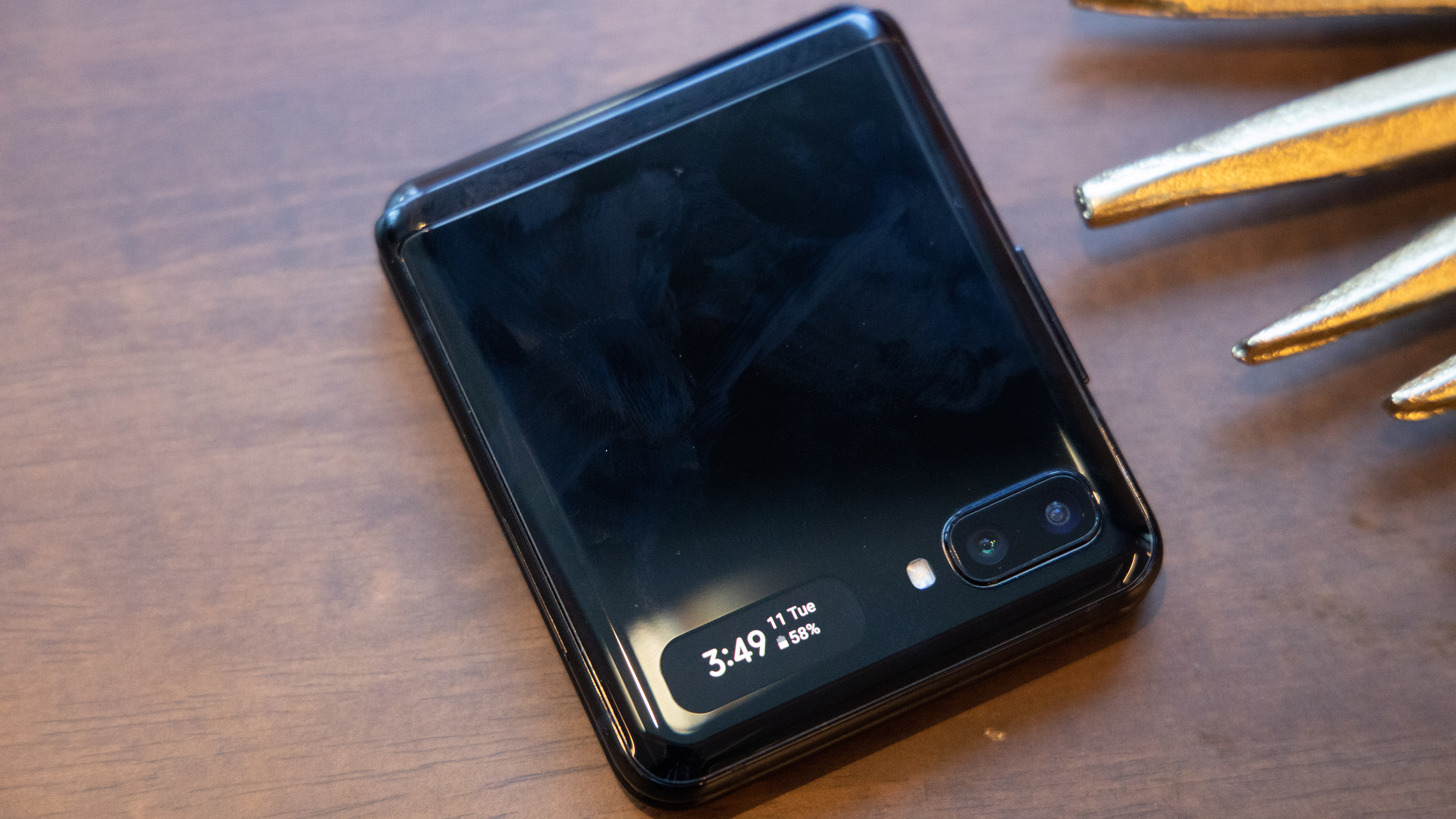
That small Cover Display
- The 1.1-inch AMOLED outer 'Cover Display' is tiny
- Simple notifications, the time and date appear here
- Names and CallerID numbers forced to scroll if too long
There's a tiny 1.1-inch AMOLED 'Cover Display' on the outside of the Z Flip, and it has just enough space to show an incoming call from a contact – if their name is short enough – in the form of a scrolling name or phone number. That said, our 10-digit number proved too long for the entire Cover Display when we tested it out. It too had to screen like a news ticker.
Notifications, battery life and the time can also be shown on this small screen, and it does more than just display static information. You can scroll through the various sets of data on the Cover Display, plus there's a way to tap a notification on the and then open up the phone to see the app in full.
Samsung calls this contextual continuity, and it's similar feature to how apps on the Galaxy Fold series are capable of running on the outside display and instantaneously loading on the main display when you unfolded the phone.
We also like the fact that when it goes black, the Cover Display can be lit back up with a simple double tap like any other Samsung screen. That said, the scrunched-up information isn't nearly as useful as the larger Cover Display on the new Galaxy Z Fold 2 or even the Moto Razr.
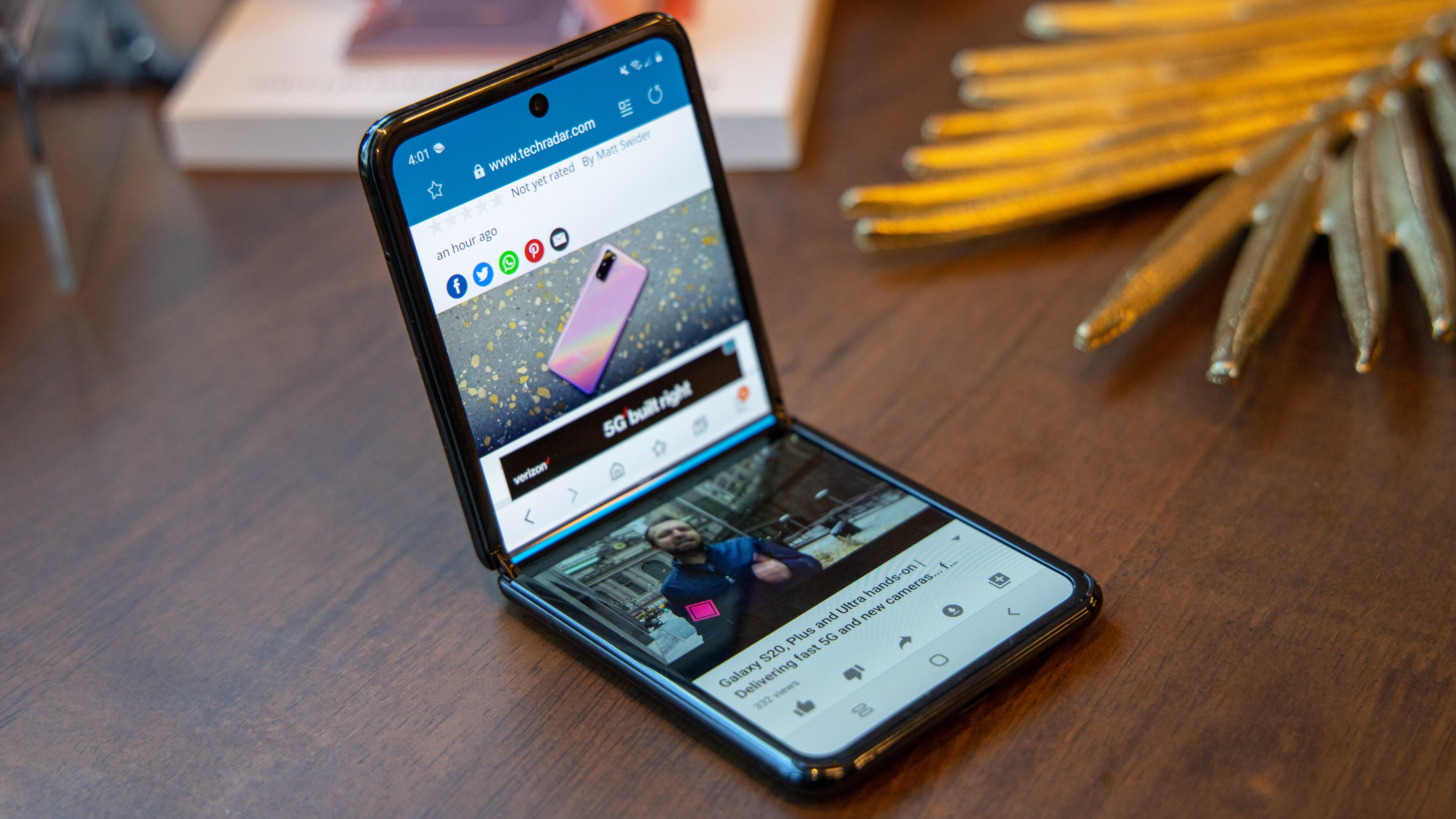
About that thin glass
- Feels more like glass than the Moto Razr and Z Fold
- It has remained durable over months of our testing
- The screen crease is faint and easy to ignore
The Galaxy Z Flip display is made of Samsung’s ‘Ultra Thin Glass’, which one-ups what we've seen from other foldables, including the Motorola Razr with its plastic OLED and its own original Galaxy Fold.
Samsung's glass-based approach felt smooth to swipe across, with a frictionless feel. The slickness is akin to Corning Gorilla Glass, which is typically found on non-folding phones. You can easily forget that you’re using a new display technology.
More important, the Ultra-Thin Glass feels pretty durable, and when we tapped on the screen, even fairly hard. We didn’t feel like the device was in any risk of breaking, which wasn't the case on the original Galaxy Fold. The Z Fold 2 we found mushy due to its protective plastic layer on top of its similar Ultra-Thin Glass layer.
Of course, we weren’t hitting the Z Flip screen as hard as a drop would hurt it – this wasn't an official drop test. But we’re still pretty confident that this is a durable foldable phone months after first using it.
There’s still a crease across the screen from left to right where the hinge is located. The crease doesn't seem as dramatic as on the Galaxy Fold, but, then again, it's across a smaller screen and it may become more pronounced as time goes on.
You're still not going to find a better foldable screen in 2020. There are two things we feel Samsung gets right about its new foldable: first, it uses thin glass to cover the inner screen. The Razr, original Fold and Huawei Mate X all use vulnerable plastic screens, and this glass has stood up well since we first started testing the Z Flip.

Camera
- 2 cameras on the outside, 1 selfie cam inside
- Uses Galaxy S10e camera tech from early 2019
- No telephoto lens, so zoom range is limited
The Samsung Galaxy Z Flip cameras are perfectly fine – and at the same time we're left wanting after reviewing the far superior Galaxy Note 20 Ultra camera.
There are two cameras on the outside of the Z Flip, and both capture 12MP photos. The f/1.8 regular camera and f/2.2 ultra-wide camera capture bright and color-rich tones in the daytime, though we've seen better nighttime photos from Samsung. Inside, there's a small cutout in the display for 10MP selfies when you have the phone unfolded.
There's no telephoto lens whatsoever, so your zoom range in limited. We're used to seeing that on cheaper versions of flagships – Samsung Galaxy S10e and iPhone 12 – but not phones this expensive.
Sticking with the S10 comparison, the photos we took are on par with Samsung's budget flagship launched in March 2019. It's either going to be perfectly fine or a major compromise, depending on how important a smartphone camera is to you.
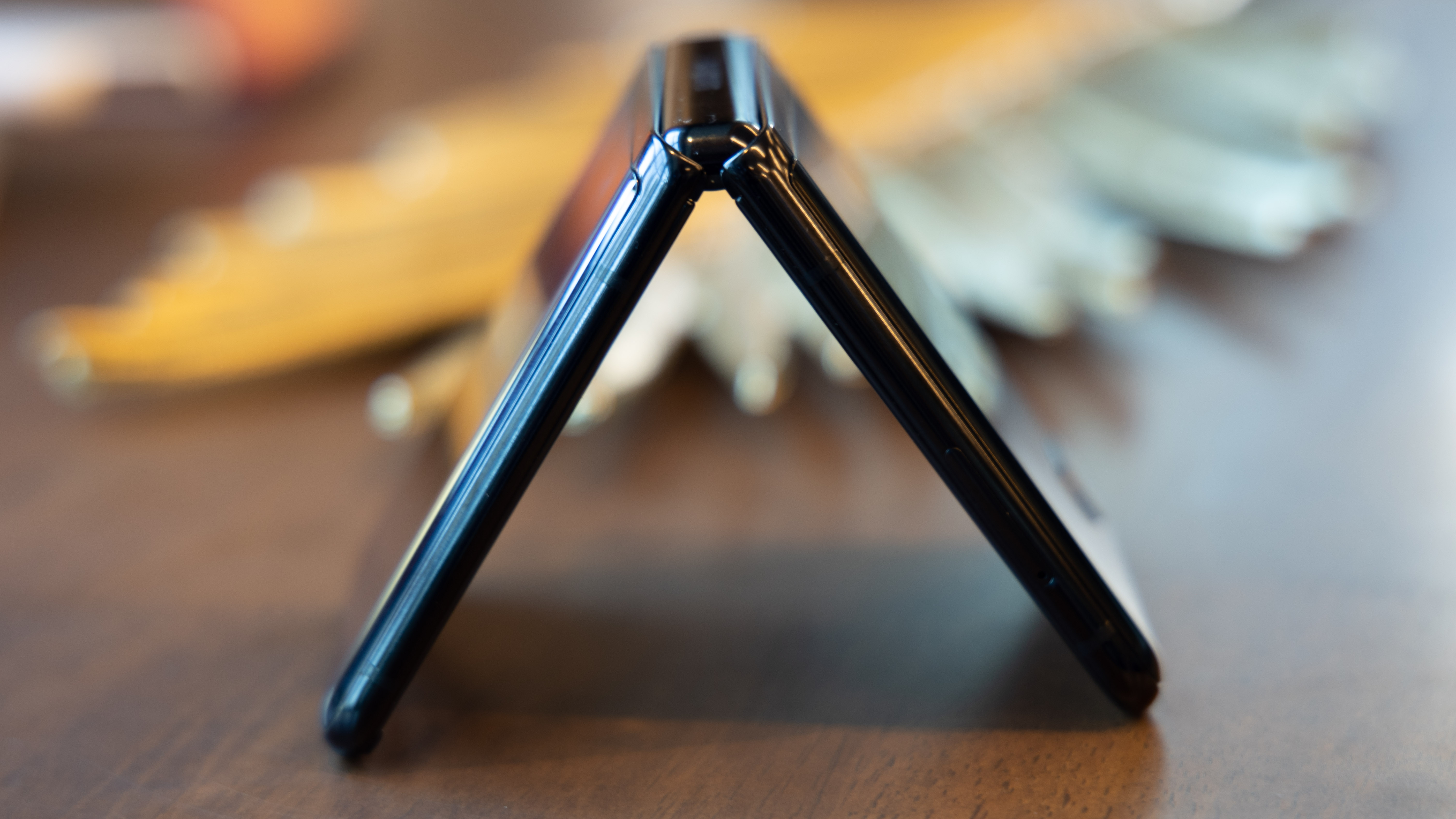
Specs and performance
- Snapdragon 855 Plus (4G LTE) or Snapdragon 865 Plus (5G)
- Plenty fast for what you can do on a compact foldable phone
- 8GB of RAM and 256GB of internal storage – no microSD card slot
The Galaxy Z Flip launched using 2019's Qualcomm Snapdragon 855 Plus chipset – on the same day that the S20 range launched with the Snapdragon 865 chip inside. It's less impressive tech squeezed into the Z Flip's smaller confines.
It's still plenty fast for what you can do on a compact foldable phone, so most people won't notice the compromise. In any event the Galaxy Z Flip 5G did upgrade things to the Snapdragon 865 Plus chipset six months later.
We've been more concerned with the fact that there's 8GB of RAM (fine) and 256GB of internal storage with no microSD card slot (not fine) tucked into the nano SIM tray. There are no other versions of the Z Flip with beefier specs, so you can run out of room despite paying so much money.
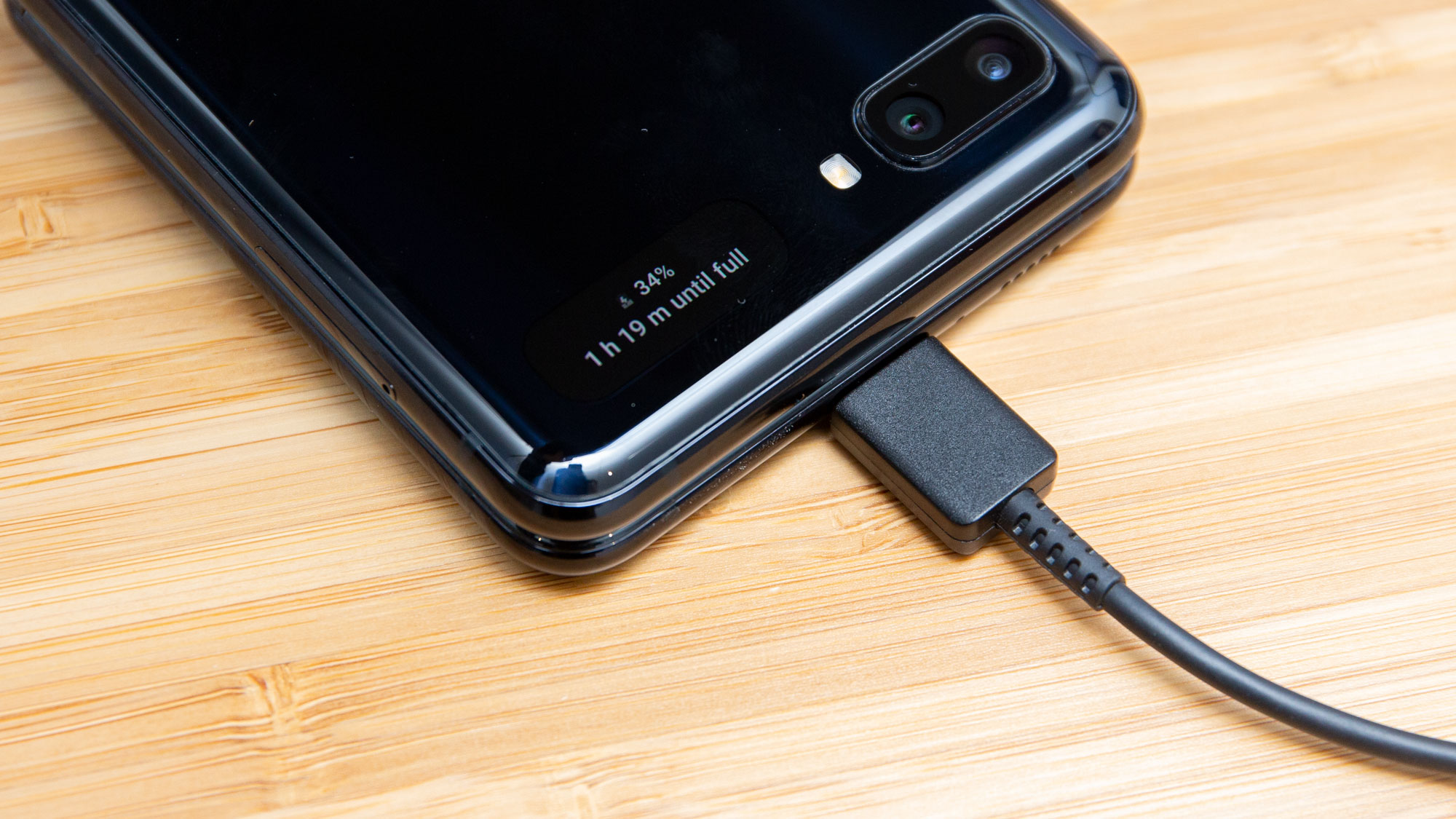
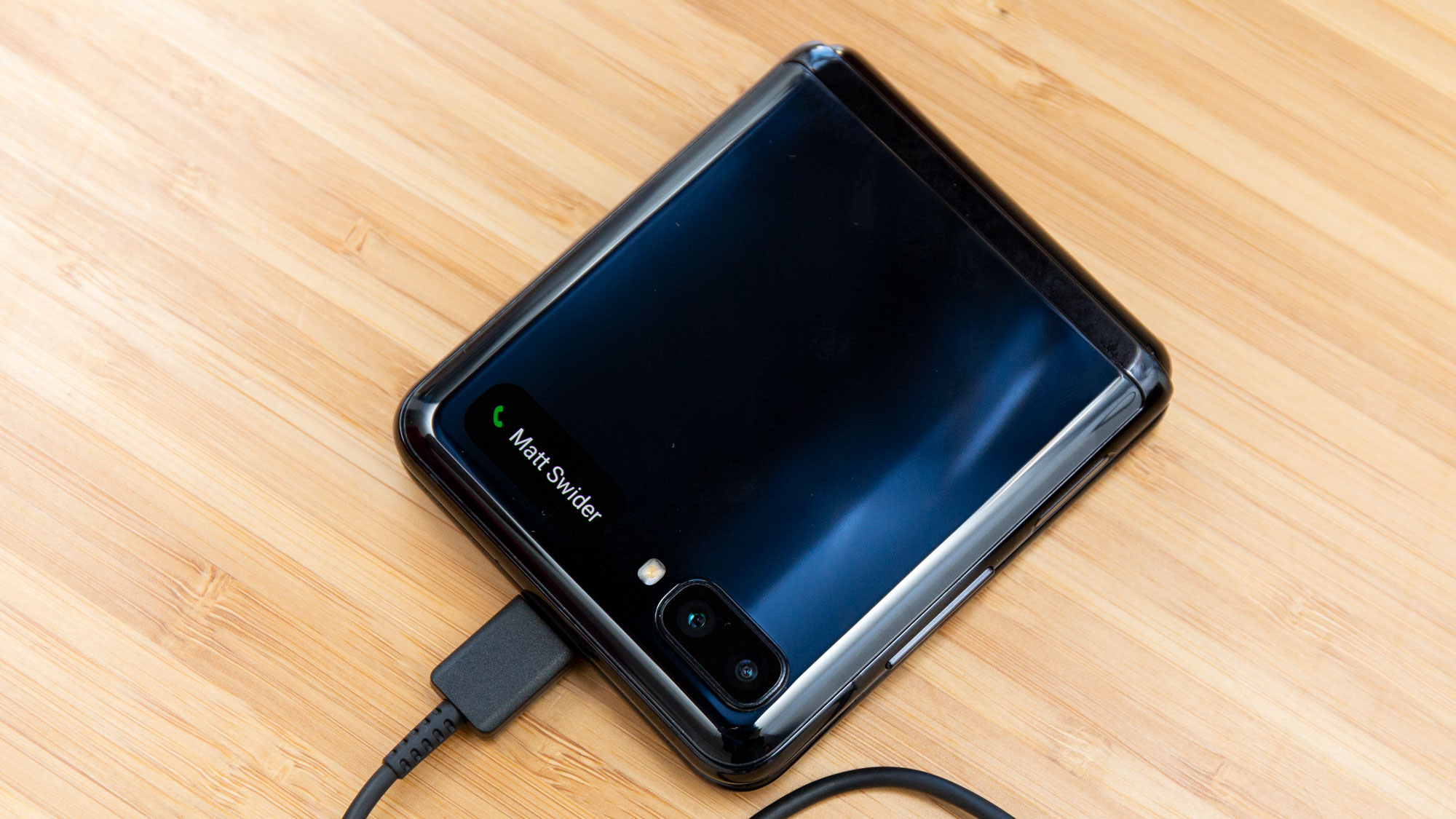
Battery life
- 3,300mAh dual battery in the phone's two halves
- Lasts a normal waking day for everyone but power users
- Wireless Qi charging placement can be a bit awkward
The Galaxy Z Flip battery life is either subpar or good enough, depending on how you look at things. It lasts a normal waking day with average use before you need to recharge it, but open that big, bright screen up more often throughout the day and it'll need a charge before the end of the night. Power users will struggle here.
That said, Samsung's 3,300mAh battery capacity made a significant difference when we tested it against Motorola's Razr's 2,510mAh capacity. The Z Flip pulls this off by embracing a dual battery design in the two halves of the phone, much like Samsung did on the larger Fold devices.
Bonus: Samsung stuck wireless charging inside of its phone (that is notably missing from the Motorola Razr). We were able to use it eventually, but had to figure out how to line up the phone with our stand-up wireless Qi charger – the charging spot in on the lower half of the phone.
Should you buy the Samsung Galaxy Z Flip?
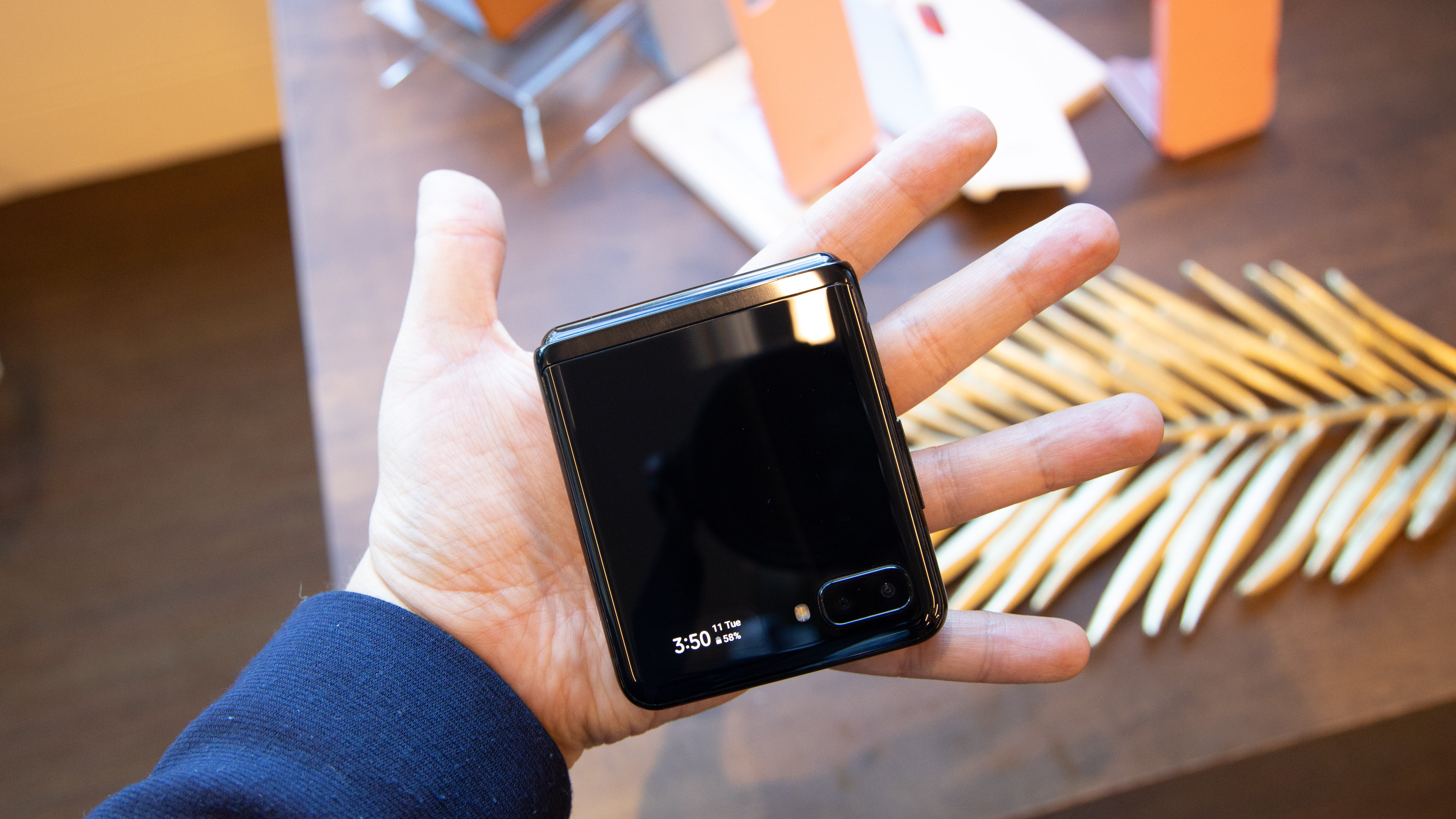
Buy it if...
You want a phone with true wow factor
The Galaxy Z Flip is a showstopper thanks to its throwback design combined with cutting-edge foldable screen technology. It'll turn heads, and that's the real reason to own this phone.
You prefer a small phone with a big screen
This is the best of both worlds. You can have a large 6.7-inch screen, yet fold it in half to carry around a device that's roughly half the size of many of today's 'small' phones.
Don't buy it if...
You want Samsung's best camera and specs
The Note 20 has Samsung's best cameras with a 5x optical zoom and 50x digital zoom, and options for more storage and 12GB of RAM. If you want the best specs, look elsewhere.
You need an affordable smartphone
Even with a price drop, the Z Flip isn't cheap. It exceeded the price of Samsung's S flagships by a lot at launch and is still hovering above what you'll pay for an S20 Plus, which has better cameras.
You can wait for version 2
Well, technically version 3, if you want to call the 5G revision version 2. The point is, we suspect a new Z Flip will launch in 2021, and that will make this phone obsolete like every other flip phone before it.
First reviewed: December 2020
